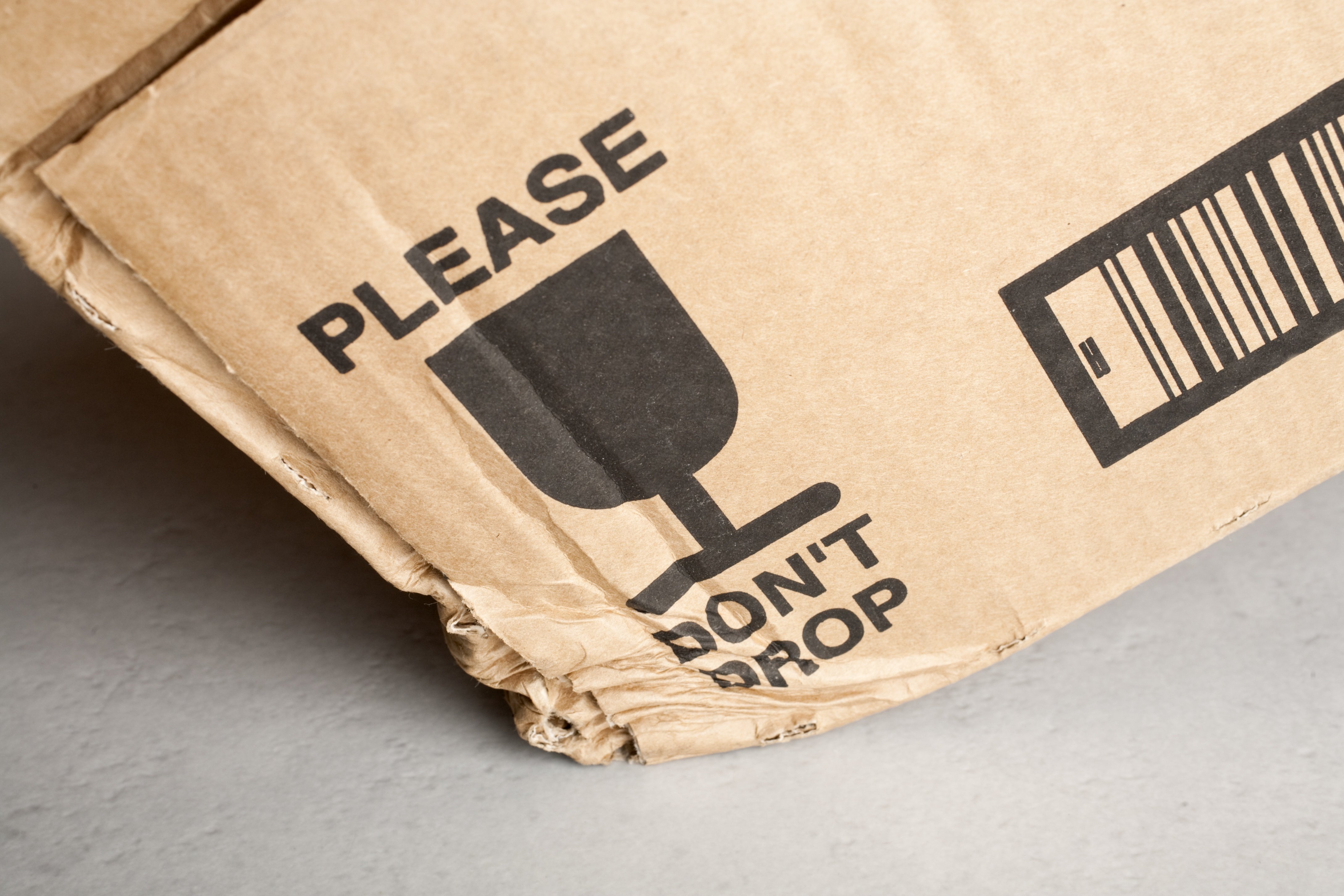Falltest
Wussten Sie, dass ein verpacktes Produkt während des Transports im Durchschnitt 10 bis 12 Mal einem starken Sturz ausgesetzt ist?
Dies bringt nicht nur das Risiko von Schäden mit sich, sondern auch das bekannte Problem "Dead on Arrival" (DOA), was bei einigen Unternehmen zu Rücksendequoten von bis zu 15 % führen kann.
Die Lösung? Falltests!
Mit gezielten Falltests stellen Sie sicher, dass die hergestellten Produkte den Herausforderungen des Transports standhalten. Sie vermeiden Beschädigungen, senken hohe Rücksendekosten und steigern die Kundenzufriedenheit.
Navigieren Sie zu:
→ Testübersicht
→ Maschinenspezifikationen testen
→ Normen und Standards
→ Gründe zum Testen

Arten von Falltests
Es gibt verschiedene Arten von Falltests, die je nach Zweck und Anwendung durchgeführt werden können.
Freier Fall Test
- Beschreibung: Das Produkt wird aus einer vorher festgelegten Höhe fallen gelassen, um die Auswirkungen auf verschiedene Oberflächen zu simulieren.
- Anwendung: Simulation typischer Fallszenarien wie beim Transport oder im täglichen Gebrauch.
- Variablen:
- Fallhöhe
- Untergrundtyp (Beton, Holz, Stahlplatte usw.)
- Ausrichtung des Produkts während des Falls
Rotations-Falltest (Rotational Drop Test)
- Beschreibung: Das Produkt wird aus einem bestimmten Winkel oder einer bestimmten Rotation fallen gelassen, um die Reaktion auf ungleiche oder schräge Aufpralle zu testen.
- Anwendung: Besonders nützlich für Produkte mit asymmetrischer Form oder empfindlichen Kanten.
Kanten- und Ecken-Falltest
- Beschreibung: Das Produkt wird gezielt auf seine Kanten oder Ecken fallen gelassen, da dies oft die schwächsten Punkte sind.
- Anwendung: Häufig verwendet bei verpackten Gütern, da Kanten und Ecken meist die ersten Aufprallpunkte während des Transports sind.
Mehrfach-Falltest (Multi-Impact Drop Test)
- Beschreibung: Mehrere aufeinanderfolgende Stürze werden simuliert, um die kumulativen Auswirkungen wiederholter Schocks zu analysieren.
- Anwendung: Produkte, die intensiv genutzt oder häufig transportiert werden.
- Beschreibung: Testen der Auswirkungen eines Sturzes auf spezifischen Untergründen wie Asphalt, Teppich, Wählen Sie usw.
- Anwendung: Besonders geeignet für Produkte, die in verschiedenen Einsatzumgebungen verwendet werden.
- Beschreibung: Das Produkt wird getestet, während es in seiner endgültigen Verpackung verpackt ist.
- Anwendung: Bewertung der Schutzqualität der Verpackung während des Transports.
- Beschreibung: Messung der Aufprallkräfte während des Falls mithilfe von Sensoren wie Beschleunigungsmessern.
- Anwendung: Detaillierte Analyse der Stoßabsorption und inneren Spannungen.
Normen
- Titel: Standard Practice for Performance Testing of Shipping Containers and Systems
- Inhalt: Simuliert Transportbedingungen, einschließlich Fall-, Stoß- und Vibrationsbelastungen auf Verpackungen.
- Anwendung: Geeignet für Verpackungen, die per Luft-, See- oder Landtransport versendet werden.
- Titel: Packaging – Complete, filled transport packages – Vertical impact test by dropping
- Inhalt: Richtlinien für Falltests von vollständig verpackten Produkten zur Prüfung der Stoßfestigkeit.
- Anwendung: Häufig verwendet für Transportverpackungen.
- ISTA 1A bis 7D: Reihe von Verpackungsstandards für Fall-, Stoß- und Vibrationssimulationen.
- ISTA 3A: Speziell für kleine Verpackungen, häufig angewendet im E-Commerce.
IEC 60068-2-31
- Titel: Environmental testing – Part 2-31: Tests – Test Ec: Rough handling shocks, primarily for equipment-type specimens
- Inhalt: Richtlinien zur Prüfung der Robustheit elektronischer Geräte gegenüber Stürzen und Stößen.
- Anwendung: Elektronische Geräte und empfindliche Ausrüstung.
MIL-STD-810H
- Titel: Environmental Engineering Considerations and Laboratory Tests
- Inhalt: Umfasst eine Vielzahl von Tests, einschließlich Falltests für militärische und industrielle Ausrüstung.
- Anwendung: Militärische Ausrüstung und Produkte, die extremen Bedingungen standhalten müssen.
IEC 60601-1
- Titel: Medical electrical equipment – General requirements for basic safety and essential performance
- Inhalt: Umfasst Falltests für medizinische Geräte, die tragbar sind oder regelmäßig bewegt werden.
ISO 11607-1/-2
- Titel: Packaging for terminally sterilized medical devices
- Inhalt: Anforderungen an die Verpackung medizinischer Geräte, einschließlich Falltests.
EN 71-1
- Titel: Safety of Toys – Mechanical and physical properties
- Inhalt: Umfasst Stoß- und Falltests für Spielzeug mit Schwerpunkt auf der Sicherheit von Kindern.
ASTM F963
- Titel: Standard Consumer Safety Specification for Toy Safety
- Inhalt: Richtlinien für Falltests und mechanische Sicherheit von Spielzeug.
IEC 62262
- Titel: Degrees of protection provided by enclosures for electrical equipment against external mechanical impacts (IK-codering)
- Inhalt: Bewertet die Stoßfestigkeit von Gehäusen, einschließlich Falltests.
IEC 60529
- Titel: Degrees of protection provided by enclosures (IP-codering)
- Inhalt: Obwohl diese Norm den Wasser- und Staubschutz abdeckt, werden auch mechanische Belastungen bewertet.
ISO 10333
- Titel: Personal fall protection equipment
- Inhalt: Umfasst Falltests für persönliche Schutzausrüstungen wie Gurte und Sicherheitssysteme.
ISO 1496
- Titel: Series 1 freight containers – Specification and testing
- Inhalt: Testmethoden für große Transportcontainer, einschließlich Stoß- und Falltests.
ASTM D5276
- Titel: Standard Test Method for Drop Test of Loaded Containers by Free Fall
- Inhalt: Richtlinien für die Durchführung von freien Falltests an verpackten Gütern.
Akkreditierung:
Sebert Schwingungstechnik: Zuverlässigkeit und weltweite Anerkennung
Sebert Schwingungstechnik ist durch den Raad voor Accreditatie (RvA), Teil der European Accreditation (EA) und ILAC, akkreditiert.
Tests in unserem ISO 17025-akkreditierten Labor werden weltweit anerkannt, im Gegensatz zu ISO 9001- oder ISTA-Labors. ISO/IEC 17025 erfordert qualifiziertes Personal, kalibrierte Geräte und validierte Methoden. Dies garantiert unabhängige und zuverlässige Testergebnisse von höchster Qualität. Unser Akkreditierungsumfang ist auf der RvA-Website einsehbar (Registrierungsnummer L540).
Vorteile des ILAC•MRA-Logos
Das ILAC•MRA-Logo auf Berichten garantiert weltweite Anerkennung, einschließlich in der EU, den USA, Japan und weiteren Ländern.
Es verhindert doppelte Tests und Bürokratie und unterstützt das Freihandelsprinzip: „Ein getestetes Produkt wird überall akzeptiert“.
- Testtyp: Freier Fall
- Bedingungen: Kalibriert und kontrolliert
- Spezifikationen:
- Maximale Höhe: 350 cm
- Maximale Höhe: 1500 cm
- Maximales Gewicht: 1350 kg
- Testtyp: Aufprall
- Bedingungen: Kalibriert und kontrolliert
- Spezifikationen:
- Maximales Gewicht: 2000 kg
- Maximale Geschwindigkeit: 4 m/s
Falltest: Minimierung des Risikos von Schäden und Tod bei Ankunft (DOA)
Ein freier Fall kann überall auftreten – sei es während der Montage in der Fabrik oder, viel häufiger, im logistischen Prozess. Messdaten zeigen, dass ein verpacktes Produkt während des Transports durchschnittlich zehn- bis zwölfmal aus beträchtlicher Höhe fällt. Dies führt häufig zu Schäden und dem bekannten „Death on Arrival“ (DOA), was bei einigen Unternehmen zu einer Rücklaufquote von bis zu 15 % führt.
Das Durchführen von Falltests bietet Unternehmen entscheidende Vorteile, um die Qualität und Zuverlässigkeit ihrer Produkte sicherzustellen.

Spezifikationen der Testmaschinen in unserem Maschinenpark
Der Präzisions-Fall- oder Drop-Tester ermöglicht es, verpackte Produkte exakt flach fallen zu lassen. Ein flacher Fall auf eine der sechs Seiten stellt die ungünstigste Aufprallart für das Produkt dar, da die Energie dabei maximal übertragen wird. Der Falltisch wird mit einer höheren Geschwindigkeit bewegt als das Produkt, wodurch dieses vom Tisch abhebt und ein kontrollierter, reproduzierbarer Aufprall ermöglicht wird.
Für Tests an Ecken oder Kanten ist der Falltester mit einer Fixiereinrichtung ausgestattet, die die Verpackung in der richtigen Position hält. Dies macht den Präzisions-Falltester ideal für Endkontrollen von Verpackungen und Produkten.
Spezifikationen:
- Fallhöhe: Stufenlos einstellbar zwischen 1 und 365 cm
- Maximales Testgewicht: 68 kg
Für Produkte, die zu groß oder zu schwer für den Präzisions-Falltester sind, bietet der eine passende Lösung. Im Labor kann damit eine kontrollierte Fallhöhe von bis zu vier Metern erreicht werden. Das Produkt oder die Palette fällt dabei auf eine seismische Masse von über 50 Tonnen. Außerhalb des Labors ist die Fallhöhe prinzipiell Quick Release Hook unbegrenzt.
Dieser Test ist ideal für große Objekte, bei denen die Aufprallbelastung präzise erfasst wird. Dadurch können realistische Daten über die Belastungen gewonnen werden, denen ein Produkt während des Transports ausgesetzt sein kann.
Spezifikationen:
- Fallhöhe: Unbegrenzt
- Maximales Testgewicht: 4.000 kg
Der Geschwindigkeits-Falltester ist speziell für kleine Objekte entwickelt, die extremen Kräften ausgesetzt sind. Dieser Tester erreicht eine Geschwindigkeit von 10 Metern pro Sekunde, wodurch schwere Aufprallszenarien präzise simuliert werden können. Dadurch lassen sich Schwachstellen im Design schnell identifizieren.
Der Geschwindigkeits-Falltester ist ein wertvolles Werkzeug für die Prüfung von Produkten wie elektronischen Geräten, bei denen Präzision und Haltbarkeit von entscheidender Bedeutung sind.
Spezifikationen:
- Fallhöhe: Stufenlos einstellbar zwischen 1 und 500 cm
- Maximales Testgewicht: 35 kg
Produkte wie Mobiltelefone erleben während ihrer Lebensdauer Hunderte kleiner Stürze. Der Repeated Rotational Free Fall Tester simuliert diesen Prozess, um Ermüdungsschäden zu identifizieren. Dies trägt dazu bei, Produkte robuster zu machen und ihre Widerstandsfähigkeit im täglichen Gebrauch zu verbessern.
Spezifikationen:
- Fallhöhe: 50 cm
- Maximales Testgewicht: 5 kg
6 gründe, warum diese Tests wertvoll sind:
Produkte durchlaufen während des logistischen Prozesses oft mehrere freie Fälle, die zu Beschädigungen oder Defekten führen können. Die Geräte von Sebert Schwingungstechnik können diese Bedingungen präzise simulieren, sodass Produkte im Voraus auf Schwachstellen getestet werden.
Beschädigte Produkte, die bei Ankunft nicht funktionsfähig sind, verursachen hohe Rücklaufquoten (in einigen Fällen bis zu 15 %). Durch vorherige Tests der Produkte können Sie das Risiko fehlerhafter Lieferungen erheblich reduzieren.
Indem Defekte während des Transports vermieden werden, können Unternehmen bei Rücksendelogistik, Ersatz für defekte Produkte und Reputationsschäden bei Kunden sparen.
Falltests identifizieren strukturelle Schwächen in Verpackungen oder Produkten. Dadurch können Sie das Design verbessern, um zukünftige Schäden zu vermeiden.
Durch die Lieferung eines robusteren Produkts, das den Transportbedingungen standhält, erhöhen Sie die Kundenzufriedenheit und stärken Ihren Markenruf.
Viele Märkte und Branchen verlangen, dass Produkte bestimmten Sicherheitsstandards für den Transport entsprechen. Sebert Schwingungstechnik unterstützt Sie dabei, diese Standards zu erfüllen.
Mit den Falltests von Sebert Schwingungstechnik vermeiden Sie diese Probleme. Unsere hochmoderne Geräte simulieren realistische Fallszenarien, sodass Sie Schwachstellen in Ihrem Produkt identifizieren und minimieren können.
Do you have any questions?
Want to learn more about our testing methods or specific tests? Our experts are here to help with any inquiries you might have. Reach out today and find out how the Sebert Group can support you in delivering unmatched quality and reliability.
